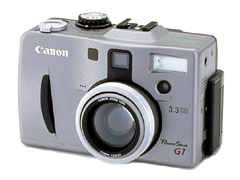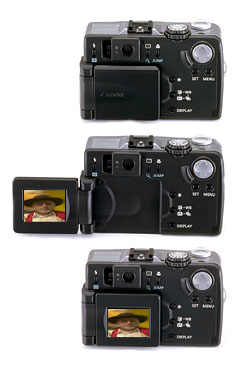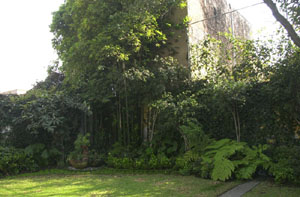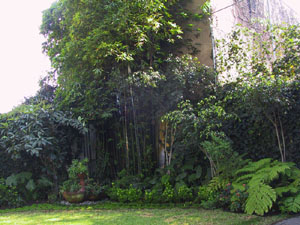| Back to MAGAZINE |
Digital
Corner
|
|
First
part
|
 |
|
|
|
|
We need to start out by defining the nature of this review. You need to know if you can find here what you want. There are already a good number of resources with information about this camera, some of which we even include at the end of this review, in the form of links. They are all very good, however they do not give you a report from someone who has actually used the camera in a practical manner. What we do not offer you, will be comparative studies and benchmark results of a technical nature, for that we believe there are other sources. Neither do we engage with a list of specifications, as again these are well presented in some of the links we have collected for you. Our approach is totally subjective much like you would, as a photographer. We explore the features of a new camera with the same instincts you have and in the end we try to come to conclusions. Every time I want to make a reference to this new digital camera from Canon, I seem to forget the name, which tells me something. I believe they could have done better naming it, either that or I am getting old. However I do remember other camera names, so I suspect that it's too generic a name to make an impact. We will dispense then with the "PowerShot" reference and just call it the G1. The Canon G1. Like in other reviews, I will make reference to other models of other cameras knowing full well that they do not represent every make there is, only the most popular ones and the ones that we happen to own. I will start with trivial things but which are not without their importance. I like the strap that came with this camera as one of the better ones of all the cameras in this price range. The reason that I like it has to do with the possibility for stringing the strap around my hand in order to hold the camera tighter in my palm. The fact that the strap is connected only on one side of the camera allows for a greater freedom of movement. You can cradle the lens cap in your palm together with the camera, something that on other cameras just ends up dangling in the air. The feel and look of the G1 is excellent, the finish and weight just seems right. It definitely does not give the impression you are taking pictures with a toy, such as the Epson 3000z does. However, the cover over the USB connections on the camera has an exceptionally poor design, I can't imagine that it will stand up to heavy use, without eventually falling off. |
|
|
The batteries are again quite another thing compared to the other cameras in this price range. The Canon G1 does not use the traditional AA NickCad batteries, instead they use Canons own which last a lot more time between charges. They come with a battery charger and they provide a very reliable service that allows for the most demanding shoots without running out of power. Obviously having extra batteries is always a recommended idea. Especially if you are travelling and far from your charger. One feature I particularly liked about the Canon G1 is that it has room for MicroDrive memory cards, these have up to one gigabyte in capacity and can therefore store a remarkable amount of images, the Nikon CoolPix nor the Epson 3000z have room for this type of memory card. The big difference with respect to the Epson 3000z and the CoolPix 990, is that the G1 LCD monitor offers the best of all worlds. It can swivel to any angle and still feel you are dealing with a traditional camera. The 3000z does not give you such a viewing option and the Nikon Coolpix requires that you twist half the camera around in order to do the same, which is not bad, other than you end up many times lost in the logic of how to hold the camera. Like if one were lost in space. With the Nikon I have often found that on a bright day it impossible to take pictures using the LCD Monitor, something that has not happened to me with the G1 which works well under any light condition. As a viewfinder I found it superb. I found the logic of all the menus in the G1 were strikingly simple and clear, much like the Epson 3000z, and unlike the CoolPix, which is probably the most convoluted of them all. Although the Epson does a much better job than the CoolPix in the menu department, that camera uses some weird non photographic conventions, somethi ng that the G1 has resolved much better. For instance in the EPSON when you want to set the ISO speed, all you get are three little arrows, so you really never know what the actual speed really is, in contrast the G1 does offer you specific references from 50 to 400 ASA, much like the CoolPix does. I suppose having the heritage of being a camera maker does show up in many places. Epson-Seiko are watch makers. |
|
|
Check this out, I was able to get better images with the Canon G1 than with the ten times more expensive Nikon D1. Not only that but the image file is larger 7.5 megs vs. 9 megs. I just could not believe my eyes. I went out to take these images of a corner of my garden which is quite shaded, and as you will appreciate, in the more enlarged images ( click on the picture to get the larger image) the color saturation and the color separation is noticeably better in the Canon over that done with the Nikon chip. Both cameras were set on automatic in order to see their own bias. However , we took the G1 camera out to take pictures in the late afternoon, and therefore increased the ISO speed to 400 ASA, and even though the pictures looked great on the LCD monitor, when we later looked at the images on the computer screen we were astounded, at the poor performance that the G1 camera had under those circumstances. You can see the amount of noise that the camera generated at that speed. Neither the Epson 3000z nor the Nikon CoolPix performed so badly when set at 400 ASA. When taking those Christmas pictures I also made a change of settings in the menu, increasing the contrast by one step as well as the saturation. It is obvious that the range that the sensor has on the G1 was not really capable of handling such choices, judging by the poor results we obtained. Lesson to be learned, don't use a camera you have not fully tested, when going out to make family pictures you won't have a chance to repeat. At that point I was quite uncommited to the Canon G1 camera, thinking to myself that it could not hold up to the Epson 3000z, but further tests showed me that one should go about these matters with some caution. For sure there are limits and features that are better from one model to the other, but also one has to explore all those features that a certain model has to offer. I certainly was rewarded by having explored further what else there was to this camera. |
|
First
part
|




